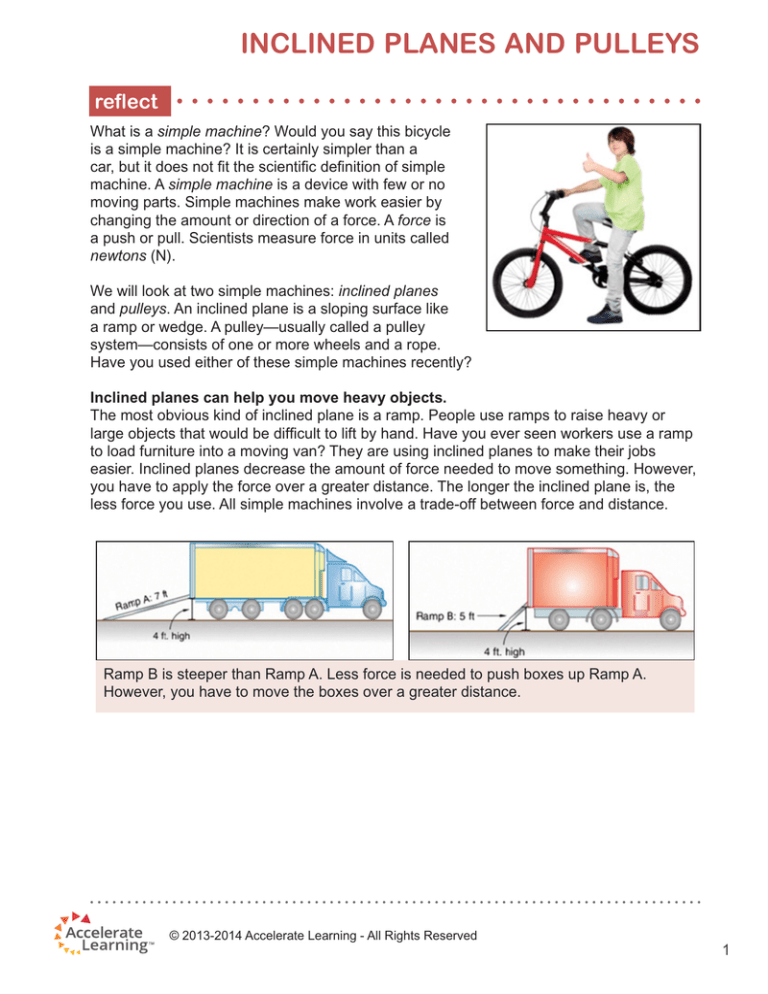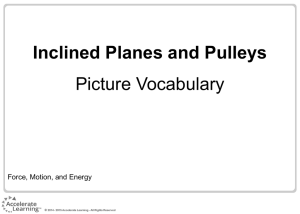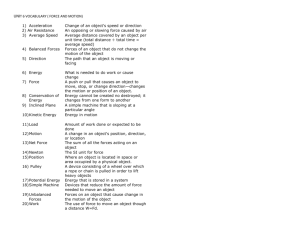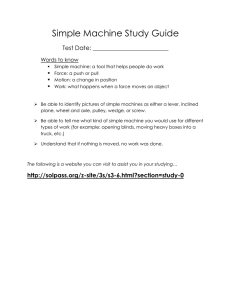
INCLINED PLANES AND PULLEYS
reflect
What is a simple machine? Would you say this bicycle
is a simple machine? It is certainly simpler than a
car, but it does not fit the scientific definition of simple
machine. A simple machine is a device with few or no
moving parts. Simple machines make work easier by
changing the amount or direction of a force. A force is
a push or pull. Scientists measure force in units called
newtons (N).
We will look at two simple machines: inclined planes
and pulleys. An inclined plane is a sloping surface like
a ramp or wedge. A pulley—usually called a pulley
system—consists of one or more wheels and a rope.
Have you used either of these simple machines recently?
Inclined planes can help you move heavy objects.
The most obvious kind of inclined plane is a ramp. People use ramps to raise heavy or
large objects that would be difficult to lift by hand. Have you ever seen workers use a ramp
to load furniture into a moving van? They are using inclined planes to make their jobs
easier. Inclined planes decrease the amount of force needed to move something. However,
you have to apply the force over a greater distance. The longer the inclined plane is, the
less force you use. All simple machines involve a trade-off between force and distance.
Ramp B is steeper than Ramp A. Less force is needed to push boxes up Ramp A.
However, you have to move the boxes over a greater distance.
© 2013-2014 Accelerate Learning - All Rights Reserved
1
INCLINED PLANES AND PULLEYS
Did you know knives and axes are also inclined
planes? The cutting edges of these tools consist of
two inclined planes that come together at an angle.
The inclined planes push in opposite directions as
they cut through an object. You could never pull
a piece of firewood apart with your hands, but a
downward stroke of an axe separates the wood
easily. The longer the inclined planes are and the
sharper the angle at which they come together, the
less force you use to cut with them.
An axe head is two inclined
planes.
look out!
Simple machines don’t do your work for you. They don’t even decrease the amount of work
done. Work equals force times distance. If a simple machine decreases the force you apply
to an object, the distance over which you apply the force must increase. In other words, the
product of force times distance—the work done—does not change.
Pulley systems can help you lift heavy objects.
To make a pulley system, a rope is looped around a wheel and an object (called a load) is
attached to the rope. Pulling on the free end of the rope lifts the load. Adding wheels to a
pulley system can make it easier to lift a load.
Pulley systems can reduce the amount of force needed to lift a load. They can change the
direction of force applied to a load. They can even do both at the same time.
The rule of thumb is to count the number of ropes supporting the load. Divide the weight of
the load by this number to get the applied force needed. In some pulley systems there can
be as many as three ropes, though only two ropes may support the load.
© 2013-2014 Accelerate Learning - All Rights Reserved
2
INCLINED PLANES AND PULLEYS
what do you think?
Pulley systems make it easier to lift a load, because each part of the system supports part
of the load’s weight. Examine these three pulley systems. In which system do you use
the least force to lift the load? In which system do you move the load over the greatest
distance? Based on your answers, what can you conclude about pulleys? (The answer is at
the end of the companion, following the What do you know? section.)
Each pulley system is lifting a load equal to five newtons. Pulley Systems 1 and
3 change the direction of the force. Pulling down on the rope lifts up the load.
This is helpful because it is easier to pull down than to lift up. In Systems 2 and
3, extra wheels and ropes support the loads. This reduces the force needed to
lift each load.
© 2013-2014 Accelerate Learning - All Rights Reserved
3
INCLINED PLANES AND PULLEYS
Getting Technical: Pulleys and Elevators
This picture shows all the pulleys that raise
and lower an elevator. Cables attached to
the elevator pass over the yellow pulley
wheels. One end of each cable attaches to
the elevator. The other end of each cable
is attached to a heavy weight that weighs
about as much as the elevator. (Don’t
worry—the cables are very strong!)
The purpose of the weight is to balance the
elevator. Adding a relatively small force to
one side causes the weight to fall and the elevator to rise. Adding a relatively small force
to the other side causes the elevator to fall and the weight to rise. Without the weight, the
motor would need to exert much more force to move the elevator up and down.
what do you think?
Earlier in this companion you analyzed three different pulley systems. Because System 3
contains the most pulleys, you use the least force to lift the load. However, you also lift the
load over the greatest distance.
What do you know?
Below you see three ramps. You want to lift an object from the lower level to the upper
level. Circle the ramp that will require you to use the least force. Draw an “X” over the ramp
that will require you to use the most force.
© 2013-2014 Accelerate Learning - All Rights Reserved
4
INCLINED PLANES AND PULLEYS
connecting with your child
Force and Pulleys
In this investigation you and your child will
measure the force needed to lift a weight
using several different pulley systems. This
is what you will need:
1. About 3 meters of fairly heavy fishing
line. (You need fishing line because in
this investigation your pulley systems
will not contain pulley wheels. Fishing
line will not add much frictional force.)
2. A weight weighing several kilograms
with a ring or handle on top.
3. A high point (e.g., a bar, ring, or
knob) you can loop the fishing line
over. (The knob or handle of an open
door at the top of a cabinet will work.
A ceiling light fixture will also work.)
4. A spring scale to measure force. If you
don’t have a spring scale, you can
measure force indirectly using cups of
pennies or other small masses. You
will need to tie one end of the line to
the weight and the other end to the
cup; then, loop the cup over the high
point and gradually add pennies to
the cup until the weight is lifted off
the ground. Record the number of
pennies necessary to lift each weight
a certain distance off the ground;
this provides you with a reasonable
estimation of comparable forces.
With your child, follow this procedure:
1. Weigh the weight with the spring
scale, and record the value.
2. Tie the line to the weight, loop the line
over the high point, and tie the other
end to the hook on the spring scale.
Pull down and measure how much
force it takes to lift the weight. Record
the value.
3. Tie the line to the high point, loop the
line through the ring on the weight,
and tie the other end to the spring
scale. Measure the force needed to
lift the weight when you pull up on the
spring scale. Record the value.
4. Compare the values you recorded in
Steps 1–3. Which system required
you to apply the least force to lift the
weight?
5. Create other pulley systems by
looping the line multiple times
through the ring on the weight and
over the high point. Measure the
force needed to lift the weight in each
case. Observe how the force varies
with the number of lines supporting
the weight.
Discuss the results. Compare the force
needed to lift the weight for the various
pulley systems. Look for patterns related
to the force needed to lift, number of lines
supporting the weight, and distance over
which you pulled the line to lift the weight.
Here are some questions to discuss with
your child:
1. What are some examples of pulley
systems or inclined planes you have
seen in everyday life?
2. How does a pulley system help you
lift something? How does an inclined
plane help you lift something?
3. Does a pulley system or an inclined
plane reduce the amount of work you
have to do? Explain.
© 2013-2014 Accelerate Learning - All Rights Reserved
5




